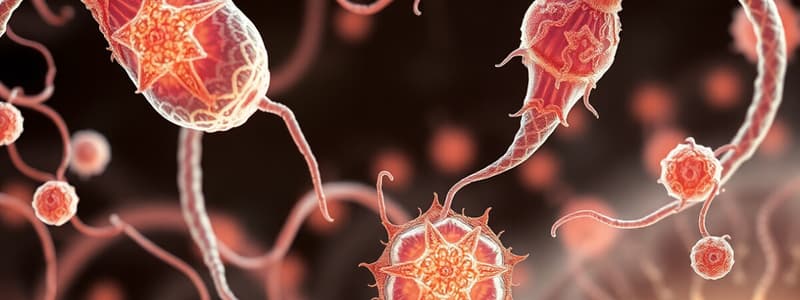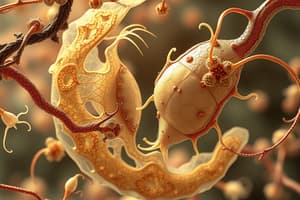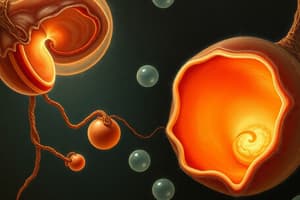Podcast
Questions and Answers
What is the first stage of development in the process of spermatogenesis?
What is the first stage of development in the process of spermatogenesis?
- Spermatids
- Primary spermatocytes
- Secondary spermatocytes
- Spermatogonia (correct)
What characterizes primary spermatocytes in terms of size and appearance?
What characterizes primary spermatocytes in terms of size and appearance?
- They are characterized by thin and flat structures.
- They display irregular shapes with fragmented chromatin.
- They are round, large cells with dense, round nuclei. (correct)
- They are the smallest cells and have elongated nuclei.
In spermatogenic epithelium, where are primary spermatocytes typically located?
In spermatogenic epithelium, where are primary spermatocytes typically located?
- In the 2nd to 4th layer of spermatogenic epithelium (correct)
- In the lumen of the seminiferous tubules
- At the outermost layer of the testis
- At the basement membrane
What is the chromatin structure observed in primary spermatocytes?
What is the chromatin structure observed in primary spermatocytes?
Which of the following best describes the growth phase leading to the formation of primary spermatocytes?
Which of the following best describes the growth phase leading to the formation of primary spermatocytes?
What is the primary purpose of spermatogenesis?
What is the primary purpose of spermatogenesis?
During which phase does spermatids transform into spermatozoa?
During which phase does spermatids transform into spermatozoa?
What is the ploidy level of secondary gametocytes in sperm production?
What is the ploidy level of secondary gametocytes in sperm production?
Which type of cells are Leydig cells?
Which type of cells are Leydig cells?
Where does the process of spermatogenesis begin?
Where does the process of spermatogenesis begin?
What structure surrounds the testes and creates partitions within them?
What structure surrounds the testes and creates partitions within them?
What is the role of spermatogonia in spermatogenesis?
What is the role of spermatogonia in spermatogenesis?
Which of these processes is part of oocytogenesis?
Which of these processes is part of oocytogenesis?
What is the primary function of Sertoli cells in the seminiferous tubules?
What is the primary function of Sertoli cells in the seminiferous tubules?
Which spermatogenic cell is considered the youngest in the series?
Which spermatogenic cell is considered the youngest in the series?
What structured part of the testis connects the seminiferous tubules to the efferent ductules?
What structured part of the testis connects the seminiferous tubules to the efferent ductules?
What type of spermatogonia are responsible for replacing themselves?
What type of spermatogonia are responsible for replacing themselves?
Which process is defined as the development and maturation of spermatozoa?
Which process is defined as the development and maturation of spermatozoa?
Which of the following structures is NOT part of the male reproductive system's sperm transport pathway?
Which of the following structures is NOT part of the male reproductive system's sperm transport pathway?
At which stage does sperm maturation begin during an individual's development?
At which stage does sperm maturation begin during an individual's development?
Which of the following is true regarding the appearance of spermatogonia?
Which of the following is true regarding the appearance of spermatogonia?
What is the process by which spermatids mature into spermatozoa?
What is the process by which spermatids mature into spermatozoa?
Which of the following describes the structure of mature sperm cells, or spermatozoa?
Which of the following describes the structure of mature sperm cells, or spermatozoa?
Which stage directly precedes the transformation of spermatids into mature sperm cells?
Which stage directly precedes the transformation of spermatids into mature sperm cells?
What do spermatids develop during spermiogenesis?
What do spermatids develop during spermiogenesis?
What is the term for the process of sperm cell formation from germ cells?
What is the term for the process of sperm cell formation from germ cells?
What process do primary spermatocytes undergo to become secondary spermatocytes?
What process do primary spermatocytes undergo to become secondary spermatocytes?
Where are secondary spermatocytes typically found in seminiferous tubules?
Where are secondary spermatocytes typically found in seminiferous tubules?
Which statement accurately describes the appearance of secondary spermatocytes compared to primary spermatocytes?
Which statement accurately describes the appearance of secondary spermatocytes compared to primary spermatocytes?
What occurs immediately after secondary spermatocytes undergo their meiotic division?
What occurs immediately after secondary spermatocytes undergo their meiotic division?
What characteristic distinguishes spermatozoa heads in various species?
What characteristic distinguishes spermatozoa heads in various species?
Flashcards are hidden until you start studying
Study Notes
Spermatozoa and Fertilization
- Male gametes, or spermatozoa, develop through a process called spermatogenesis.
- The process is critical for recognizing homologous cells of the opposite sex in species, particularly during external fertilization.
- Involves the transformation of undifferentiated germ cells (spermatogonia) into mature spermatozoa.
- Initiates in the embryonic testis and completes in sexually mature testes.
Spermatogenesis Process
- Consists of multiple stages including spermatogonium, primary spermatocyte, secondary spermatocyte, spermatid, and spermatozoa.
- Starts with spermatogonia, diploid cells located near the basal lamina of seminiferous tubules.
- Primary spermatocytes derive from spermatogonia during the growth phase, characterized as the largest cells with condensed chromatin.
- Secondary spermatocytes form from primary spermatocytes following meiosis, evolving rapidly into spermatids.
Spermiogenesis
- Refers to the transformation of spermatids into mature spermatozoa.
- Spermatids undergo physical changes including nucleus and cytoplasm remodeling.
- Resulting spermatozoa are motile cells with a defined head, neck, and tail structure.
Anatomy of the Testis
- Tunica albuginea is a fibrous capsule surrounding the testes, also forming septae that divide the interior into lobules.
- Leydig cells, interstitial cells between seminiferous tubules, secrete testosterone and are closely associated with blood vessels.
- Seminiferous tubules are responsible for housing spermatogenic cells and organizing the maturation process.
- Connecting structures include rete testis and efferent ductules, facilitating sperm movement toward the epididymis.
Spermatogenic Cell Types
- Spermatogonia: Youngest diploid cells, responsible for the initiation of the spermatogenesis process.
- Primary Spermatocytes: Largest cells, transition from spermatogonia, undergo meiosis to lead to secondary spermatocytes.
- Secondary Spermatocytes: Form from primary spermatocytes after meiosis I, immediately undergoing meiosis II to become spermatids.
- Spermatids: Immature sperm that are surrounded by Sertoli cells, undergo transformation into mature spermatozoa.
- Spermatozoa: Final sperm cells with specialized structures necessary for motility and fertilization.
Sperm Maturation Overview
- Sperm maturation initiates in embryonic development and continues until sexual maturity in males.
- The entire maturation cycle is critical for the production of viable sperm capable of fertilizing an egg.
Studying That Suits You
Use AI to generate personalized quizzes and flashcards to suit your learning preferences.




